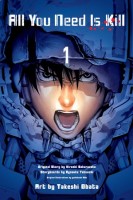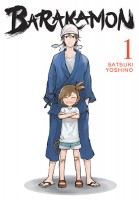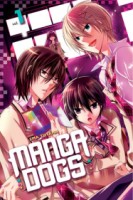A few weeks ago, we promised that we’d be introducing some new features to complement our regular link-posts. Today we’re launching the first of those columns, Bookmarked! Every Wednesday, Brigid and I will discuss what’s sitting on our nightstands, and invite someone from the mangasphere to join the conversation. Our first guest is Deb Aoki, who’s been a force in manga journalism for almost a decade. Deb was the editor of About Manga from 2007 to 2013, and is currently a contributor to Publisher’s Weekly. She also runs her own website Manga Comics Manga, which offers a mixture of reviews and commentary.
 Kate: First up for me is Takeshi Obata’s adaptation of All You Need Is Kill. The premise is equal parts Ground Hog Day and Stormship Troopers: a soldier dies on the battlefield, only to relive the same day over and over again. Naturally, he takes advantage of this time-loop to learn more about his alien foes, honing his hand-to-tentacle combat skills with each ill-fated mission. Though it’s a boffo premise for a story, the execution—in manga form, at least—is mediocre. The combat scenes are rendered with gory zest, but the aliens themselves aren’t terribly frightening; if anything, they look like irradiated dust mites. The manga also suffers from a bad case of Explanation-itis, with too many text boxes filling gaps in the story. My verdict: skip the manga and read Hiroshi Sakurazawa’s original novel instead.
Kate: First up for me is Takeshi Obata’s adaptation of All You Need Is Kill. The premise is equal parts Ground Hog Day and Stormship Troopers: a soldier dies on the battlefield, only to relive the same day over and over again. Naturally, he takes advantage of this time-loop to learn more about his alien foes, honing his hand-to-tentacle combat skills with each ill-fated mission. Though it’s a boffo premise for a story, the execution—in manga form, at least—is mediocre. The combat scenes are rendered with gory zest, but the aliens themselves aren’t terribly frightening; if anything, they look like irradiated dust mites. The manga also suffers from a bad case of Explanation-itis, with too many text boxes filling gaps in the story. My verdict: skip the manga and read Hiroshi Sakurazawa’s original novel instead.
I’m also reading My Love Story!! a new-ish shojo title that’s been getting good buzz around the web. The key to its success, I think, is the artwork. Though most of the characters conform to shojo norms—button-cute faces, artfully tousled hair—Takeo, the hero, looks like a graduate of Cromartie High, a big bruiser with a gorilla’s face. His size and fearsome appearance are, of course, played for laughs, but artist Kazune Kawahara also plays against type, revealing Takeo’s gentler (and nimbler) side through brief but hilarious vignettes involving treed cats, imperiled children, and falling i-beams.
What I like best about My Love Story!!, however, is the friendship between Takeo and Sunakawa, his impossibly handsome, cool friend. Sunakawa finds Takeo’s social cluelessness exasperating, but remains staunchly loyal to his buddy. As someone who’s had her fill of cocky shonen characters, I found it refreshing to see Takeo discuss his anxieties to Sunakawa so openly; younger female readers may be pleasantly happy to discover that boys worry about their looks and “it” factor as much as girls do, even if it isn’t socially acceptable to admit such fears. And if that last sentence made you say, “Holy Phil Donahue, Batman!” rest assured that Takeo and Sunakawa’s exchanges are blunt and funny, not touchy-feely; Sunakawa never sugar-coats his advice to Takeo. (He’s a big proponent of the “She’s just not that into you” school of keepin’ it real.)
Brigid: Barakamon is the story of an up-and-coming calligrapher, Seishuu Handa, who retreats to a remote island after putting his career in jeopardy by getting physical with an expert who calls his work “highly conformist.” There’s a lot of city-slicker-goes-to-the-country humor, with the locals invariably getting the better of Seishuu—especially the children, who have turned his rented house into their own clubhouse and have no intention of letting it go. The chief miscreant is a very young girl named Naru who is cute and inquisitive but suffers from the irritating habit of referring to herself in the third person. Manga-ka Satsuki Yoshino has a weak sense of anatomy—the characters often look like a pile of clothes with no structure underneath, and the parts of the body are frequently out of proportion—but she also does a good job of evoking the open, rural area and the playfulness of the children. This is a charming book with broad humor and a nice sense of atmosphere.
Deb Aoki
My Love Story!! Vol. 2: Spring has sprung, and now that cute, sweet and petite Yamato and huge, big-hearted hulk Takeo are officially GF/BF, things are headed toward their happily ever after, right? Well, KINDA. Now Yamato wants to introduce her super cool boyfriend to her friends via a group date, and has a bit of a rude awakening when her friends are less than impressed with his uh, “gorilla-like” appearance. Will their love survive when friendship gets in the way?
My Love Story!! was one of my picks for best new manga at San Diego Comic-Con this year, and that was based on only one volume! Now that the second volume is out, the question is, can Kawahara (the creator of another fave shojo romantic comedy, High School Debut) and Aruko keep the ball rolling on what basically seems like a one-joke-wonder? Based on what I’ve seen in volume 2, it looks like they’re just getting started.
I don’t want to spoil the laughs, but there are several scenes in My Love Story!! vol. 2 that made me genuinely guffaw. Seeing Takeo wearing a skimpy apron as he works at a “Bro Café” and listening to his matter-of-fact interactions with his mom (who unsurprisingly, was a former pro wrestler) reminded me that this ensemble of quirky characters still has lots of comedy left to mine, I hope they keep it comin’.
What Did You Eat Yesterday? Vols. 4 & 5 : I was down with the whole concept of What Did You Eat Yesterday? almost as soon as Vertical announced that they licensed it for publication in English—but somehow, volumes 4 and 5 really sealed the deal for me.
Written and drawn by Fumi Yoshinaga (Ooku, Antique Bakery, Flower of Life, All My Darling Daughters, and more BL than you can shake a stick at), What Did You Eat Yesterday? seems at first like just a foodie-centric slice of life story about couple in Tokyo who just happen to be gay. Kenji is a hairdresser, who’s basically out, while Shiro the lawyer keeps his sexual preferences under wraps for professional reasons. What they have in common (besides their love for each other) is their shared love of good food. And not super fancy food either—Yoshinaga focuses on simple recipes that are inexpensive and relatively easy to make.
While the first few volumes set up the basic premise for the series and introduces us to the characters, volumes 4 and 5 make it very clear that being gay in Japan is not as simple as boys love manga would have you believe.
Kenji and Shiro deal with the everyday issues that remind them that their lives, while happily domestic, can be somewhat complicated. There are little moments that bring this point home to the reader, particularly as we observe Shiro’s discomfort as he’s forced to consider his relationship with Kenji and his relationship with his gay-ness. Shiro feeling self-conscious while they’re dining out with another gay couple or purposely standing apart while riding the subway together. Shiro enduring being cheerfully greeted with “Hey, it’s the gay guy!” by his well-meaning neighbors. Getting a request from a gay friend to help arrange the adoption of his long time partner, so his estranged family won’t automatically inherit his estate. Talking about wanting or not wanting kids, and how it’s not so easy when you’re gay in Japan. Turning down an offer to be on a TV show because it would be too difficult to maintain one’s privacy. After years of seeing fantasized M/M manga romances in BL/yaoi manga, it’s eye-opening to see the realities of gay life in Japan depicted in such a matter-of-fact way.
Mind you, there’s still a lot of witty, gentle humor in these books, so it’s not preachy or dreary. Yoshinaga is too skillful a storyteller and too funny to let things get too heavy-handed. I hope that there’s still more volumes of this manga planned for publication—but that may depend on more people getting turned on to its subtle, quirky charms. So go pick it up, why don’t you? I’d love to read volume 6 and beyond, and every additional reader who buys this manga will certainly help ensure that this will happen.
Manga Dogs, vol. 1: Kanna Tezuka is a high school girl with a secret: She’s a published professional manga artist, albeit one whose first series is near the bottom of the popularity rankings in her magazines—but hey, it’s still better than the three hunky but clueless schlubs who are her classmates in her manga art class.
The trio, Fumio Akatsuka, Fujio Fuji, and Shota Ishinomori have big dreams of manga superstardom, but very little actual talent. When the trio discover that they have a pro in their midst, they beg Kanna to be their manga mentor. Can she keep making manga, hit her deadlines and not go nuts listening to her classmates’ delusions of comics grandeur?
A quirky satire of manga making by the creator of I Am Here! and Missions of Love, Manga Dogs is kind of like the goofy younger sister of Bakuman. It definitely doesn’t take comics creation as a career as seriously as Tsugumi Ohba and Takeshi Obata’s manga about making manga, but come on, does it have to?
Manga Dogs has loads of manga in-jokes for hardcore fans (for example, Shota Ishinomori’s name is a play on “shota”, a word used to refer to underage boys and Shotaro Ishinomori, the legendary comics creator of Cyborg 009 and Kamen Rider), and enough general-purpose slapstick to make it a fun read. A very nerdy read with filled with excruciating mishaps for the heroine, and several pages of translation notes to clue readers into its many in-jokes, but fun anyway. Not for everyone, but for the manga obsessed, this new shojo comedy delivers lots of light-hearted. goofy fun.


